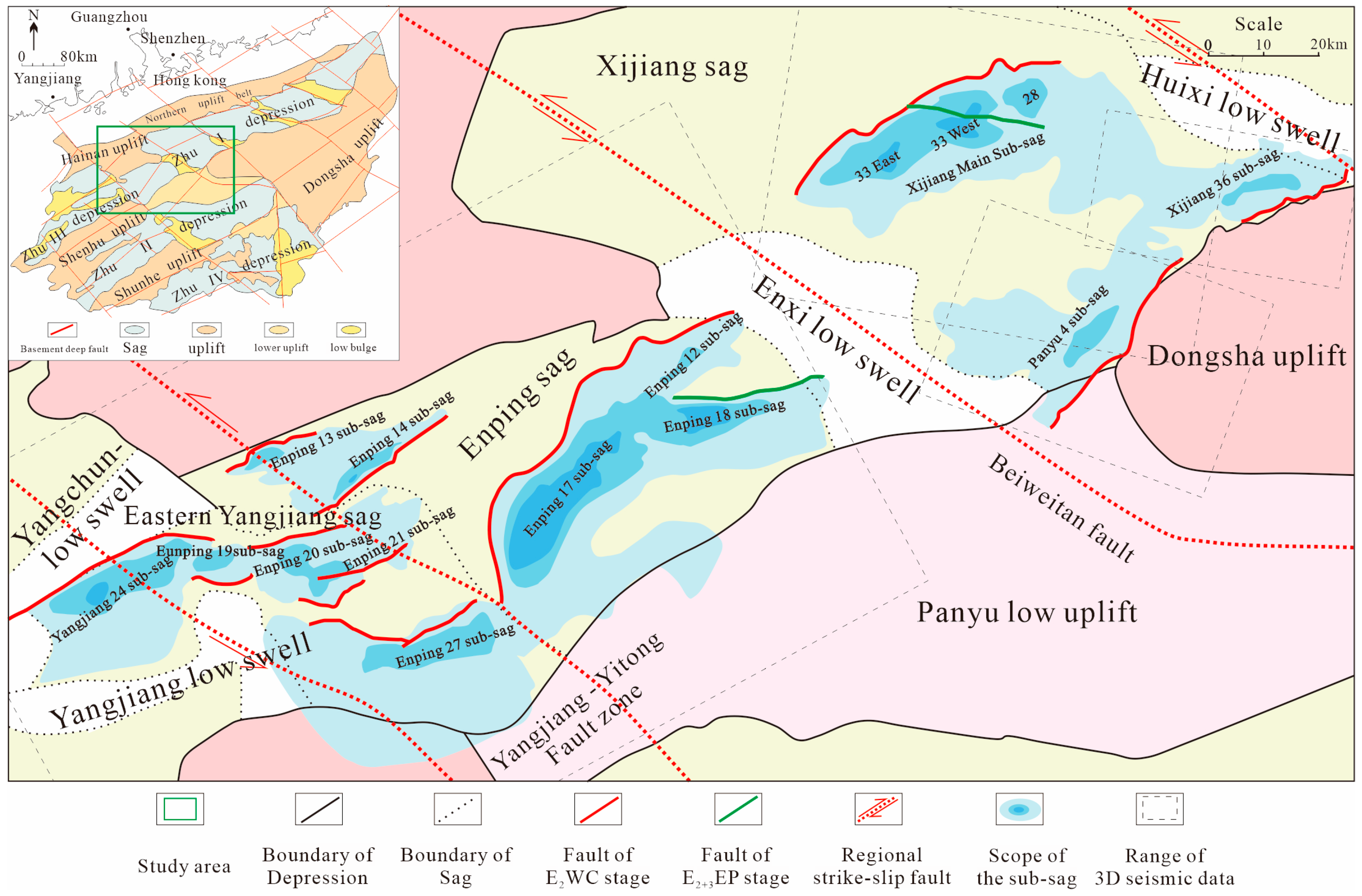Tectonic Transformation, Magmatic Activity and Subsidence Centre Migration of Eocene Half-Grabens: A Case Study of the Northern Pearl River Mouth Basin (PRMB) in the Northern South China Sea
Abstract
1. Introduction
2. Geological Setting

3. Data and Methods
4. Results
4.1. Magmatic Activity and Tectonic Transformation
4.1.1. Identification of the Magmatic Rock Mass
4.1.2. Magmatic Activity Time Analysis
4.1.3. Distribution Characteristics of Magmatic Activity and Tectonic Transformation
4.1.4. Regional Magmatic Activity Pattern
4.2. Migration of the Subsidence Centre Controlled by Tectonic Transformation and Magmatic Activity
4.2.1. Axial Migration of Simple Compound Half-Grabens
4.2.2. Oblique Migration of Complex Compound Half-Grabens
4.3. Migration Rule and Cause of the Settlement Centre of the Wenchang Formation in the Study Area
5. Discussion
5.1. Analysis of the Genesis of Magmatic Activity Dynamics
5.2. Tectonic Transformation and Magmatic Activity
6. Conclusions
- Although the drilling data for the study area reveal fewer magmatic rocks, the seismic data reflect more obvious magmatic activity here. For example, the intermediate-basic lava showed a medium-high frequency, large amplitude, suitable continuity, and parallel–subparallel reflections in the form of tabular and shields. The lava is subcircular or elliptical in the plane. It is manifested as a hypabyssal magmatic intrusion of a magmatic diapir, which can be identified by a large-amplitude abnormal geological body and convex reflection in the basement. The magmatic activity time in the study area is generally characterized by early development in the east and late development in the west. However, in the Yangjiang-Yitong Fault Zone, magmatic activity is very complicated. At the northernmost end, the magmatic activity in the Enping 20 and 21 subsags developed at the E2WC and E2+3EP stages. To the south, the magmatic activity in the Enping 27 subsag developed at the N1ZJ, N1HJ, and N1YH stages. During the formation period of the fault basin, the location of magmatic activity depended on the angle between the regional stress direction and the axis of the basin. The regional stress rotated from NW–SE to S–N at the E2WC stage, and the angle between the regional stress and the axis of the basin was greater than 45° and changed constantly. The magmatic activity in the eastern Yangjiang-Yitong Fault Zone was more complex than that in the Zhu I Depression.
- The PRMB at the northern continental margin of the South China Sea is located at the intersection of the Pacific tectonic domain and the Neo-Tethys tectonic domain. Since the Mesozoic, it experienced the interaction of active and passive continental margins and was greatly affected by the Indian plate and the Pacific plate. Since the Cenozoic, the two-way convergence rates and directions of the Pacific plate and Indian plate towards the Eurasian plate continuously changed. Whether the Pacific plate or the Indian plate plays a leading role in tectonic evolution and magmatic activity remains controversial. In this study, magmatic activity was manifested as early development in the east and late development in the west. The location, shape, and distribution of magma intrusion are related to the angle between the regional extension direction and the axis of the basin and are also related to the fault occurrence. This result matches the perspective that the Pacific plate plays a dominant role. During the early Eocene (E2WC stage), the convergence rate of the Indian plate was higher. The convergence direction of the Pacific plate was NWW, and the regional extension direction of the northern continental margin of the South China Sea was NW–SE. The extension direction continuously rotated clockwise, the convergence direction of the Pacific plate changed to NNW, and the extension direction changed to S–N. There was also magmatic activity in the E2WC stage at the northernmost end of the Yangjiang-Yitong Fault Zone. However, in addition to dynamic genesis, magmatic activity is related to many factors, such as crust–mantle evolution, which must be further investigated.
- At the E2WC and E2+3EP stages, the regional extension direction rotated, and NW-trending regional strike-slip faults were active. The basin-controlling faults were NE, NEE, and nearly E–W faults, and their activities differed along the fault strikes. Tectonic transformation led to the migration of the basin subsidence centre at the E2WC stage. In the Xijiang Sag and Enping Sag, the subsags at the E2WC stage were simple compound half-grabens. The subsidence centre of the subsags migrated along the opposite direction, which suggests that it migrated in a convergent manner towards the NW-striking Beiweitan Fault along the basin-controlling fault. On account of the magmatic activity from the end of the early E2WC stage to the beginning of the late E2WC stage, in the central part of the Xijiang main subsag, the subsidence centre migrated towards the basin-controlling fault. In the northern part of Panyu, 4 subsags were intensely uplifted, and the subsidence centre migrated to the southwest. The subsags in the Yangjiang-Yitong Fault Zone are complex compound half-grabens. The basin-controlling faults of the subsags strike nearly E–W, and their inclinations are opposite. The faults control the subsidence of the subsags, so the subsags partially overlap. Under the influence of E2WC stage magmatic activity, the subsidence centre migrated obliquely from one subsag to the opposite one. In conclusion, against the background of the rotation of the regional extension direction, at the E2WC stage, both tectonic transformation and magmatic activity controlled the subsidence centre migration process. AT the E2+3EP stage and Miocene, magmatic activity changed the subsags formed at the E2WC stage.
Author Contributions
Funding
Institutional Review Board Statement
Informed Consent Statement
Data Availability Statement
Acknowledgments
Conflicts of Interest
References
- Clinton, D.; Dahlstrom, A. Structural geology in the eastern margin of the canadian rocky mountains. Bull. Can. Pet. Geol. 1970, 18, 332–406. [Google Scholar]
- Morley, C.K.; Nelson, R.A.; Patton, T.L.; Munn, S.G. Transfer zones in the East African Rift system and their relevance to hydrocarbon exploration in rifts. AAPG Bull. Am. Assoc. Pet. Geol. 1990, 74, 1234–1253. [Google Scholar]
- Henry, D.C. Basement-controlled transfer zones in an area of low-magnitude extension, eastern Basin and Range province, Trans-Pecos Texas. Spec. Pap. Geol. Soc. Am. 1998, 323, 75–88. [Google Scholar]
- Ebinger, C.J. Geometric and kinematic development of border faults and accommodation zones, Kivu-Rusizi Rift, Africa. Tectonics. 1989, 8, 117–133. [Google Scholar] [CrossRef]
- Chen, J.F.; Wang, X.W.; Chen, Z.N. Analysis of Transform Structures in Extensional Fault Depressions. Geoscience 2011, 25, 9, (In Chinese with English Abstract). [Google Scholar]
- Corti, G. Continental rift evolution: From rift initiation to incipient break-up in the Main Ethiopian Rift, East Africa. Earth-Sci. Rev. 2009, 96, 1–53. [Google Scholar] [CrossRef]
- Lin, H.M.; Liu, P.; Wang, X.D.; Jia, P.M.; Li, Z.S.; Gao, X.; Que, X.M. Influences of Structural Transformation on Source-to-sink System During the Depositional Period of Wenchang Formation of Eocene in the Zhu I Depression. Geotecton. Metallog. 2021, 45, 13, (In Chinese with English Abstract). [Google Scholar]
- Schlische, R.W.; Withjack, M.O. Origin of fault domains and fault-domain boundaries (transfer zones and accommodation zones) in extensional provinces: Result of random nucleation and self-organized fault growth. J. Struct. Geol. 2009, 31, 910–925. [Google Scholar] [CrossRef]
- Zhu, H.T.; Xu, C.G.; Zhu, X.M.; Zeng, H.L.; Jiang, Z.X.; Liu, K.Y. Advances of the Source-to-Sink Units and Coupling Model Research in Continental Basin. Earth Sci. J. China Univ. Geosci. 2017, 42, 20. [Google Scholar]
- Badr, R.; El-Barkooky, A.N.; El-Araby, A.-M.; Christie-Blick, N.; Bernhardt, A. Syn-rift sedimentary response to growth folding along a rift-margin transfer zone: An example from the early Miocene of the Gulf of Suez, Egypt. Sediment. Geol. 2022, 432, 106121. [Google Scholar] [CrossRef]
- Corti, G.; Bonini, M.; Cloetingh, S.; Innocenti, F.; Manetti, P.; Sokoutis, D. Analogue modelling of continental extension: A review focused on the relations between the patterns of deformation and the presence of magma. Earth-Sci. Rev. 2003, 63, 169–247. [Google Scholar] [CrossRef]
- Corti, G.; Bonini, M.; Mazzarini, F.; Boccaletti, M.; Innocenti, F.; Manetti, P.; Mulugeta, G.; Sokoutis, D. Magma-induced strain localization in centrifuge models of transfer zones. Tectonophysics 2002, 348, 205–218. [Google Scholar] [CrossRef]
- Corti, G.; Bonini, M.; Innocenti, F.; Cloetingh, S.; Mulugeta, G.; Sokoutis, D.; Manetti, P. Rift-parallel magma migration and localisation of magmatic activity in transfer zones. Acta Vulcanol. 2003, 14, 17. [Google Scholar]
- Sun, Z.; Pang, X.; Zhong, Z.H.; Zhou, D.; Chen, C.M.; Hao, L.J.; He, M.; Huang, C.J.; Xu, H.H. Dynamics of Tertiary tectonic evolution of the Baiyun Sag in the Pearl River Mouth Basin. Earth Sci. Front. 2005, 12, 489–498, (In Chinese with English Abstract). [Google Scholar]
- Pang, X.; Zhen, J.Y.; Mei, L.F. Structural diversity of fault depressions under the background of preexisting subduction continental margin, Pearl River Mouth Basin, China. Pet. Explor. Dev. 2021, 48, 1–11. [Google Scholar] [CrossRef]
- Morley, C.K. Geometry and evolution of low-angle normal faults (LANF) within a Cenozoic high-angle rift system, Thailand: Implications for sedimentology and the mechanisms of LANF development. Tectonics 2009, 28. [Google Scholar] [CrossRef]
- Shen, M.R.; Shan, X.L.; Hao, G.L.; Liu, P.; Jia, P.M.; Xu, C.; Zhang, Z.W.; Wang, X.M. Structural difference and control mechanism of early Cenozoic depression in Yangjiang east sag, Pearl River Mouth Basin. Earth Sci. 2022; in press. (In Chinese with English Abstract). [Google Scholar]
- Parsons, T.; Thompson, G.A. Does magmatism influence low-angle normal faulting? Geology 1993, 21, 247–250. [Google Scholar] [CrossRef]
- Zhao, Y.H.; Ren, J.Y.; Pang, X.; Yang, L.L.; Zheng, J.Y. Structural style, formation of low angle normal fault and its controls on the evolution of Baiyun Rift, northern margin of the South China Sea. Mar. Pet. Geol. 2018, 89, 687–700. [Google Scholar] [CrossRef]
- Weinstein, A.; Oliva, S.J.; Ebinger, C.J.; Roecker, S.; Tiberi, C.; Aman, M.; Lambert, C.; Witkin, E.; Albaric, J.; Gautier, S.; et al. Fault-magma interactions during early continental rifting: Seismicity of the Magadi-Natron-Manyara basins, Africa. Geochem. Geophys. Geosyst. 2017, 18, 3662–3686. [Google Scholar] [CrossRef]
- Derek, K.; Ebinger, C.J.; Stuart, G.W.; Daly, E.; Ayele, A. Strain accommodation by magmatism and faulting as rifting proceeds to breakup: Seismicity of the northern Ethiopian rift. J. Geophys. Res. Solid Earth 2006, 111, 1–17. [Google Scholar] [CrossRef]
- James, E.F.; Robert, J.V. The role of accommodation zones and transfer zones in the regional segmentation of extended terranes. Geol. Soc. Am. Spec. Pap. 1998, 323, 1–45. [Google Scholar]
- Shi, H.S.; Du, J.Y.; Mei, L.F.; Zhang, X.T.; Hao, S.H.; Liu, P.; Deng, P.; Zhang, Q. Huizhou Movement and its significance in Pearl River Mouth Basin, China. Pet. Explor. Dev. 2020, 47, 447–461. [Google Scholar] [CrossRef]
- Wang, P.C.; Suo, Y.H.; Peng, G.R.; Li, S.Z.; Du, X.D.; Cao, X.Z.; Zhou, J.; Wang, G.Z.; Santosh, M.; Jiang, S.H.; et al. Three-stage extension in the Cenozoic Pearl River Mouth Basin triggering onset of the South China Sea spreading. Gondwana Res. 2022, 1–16. [Google Scholar] [CrossRef]
- Peng, G.R.; Pang, X.Q.; Xu, Z.; Luo, J.R.; Yu, S.; Li, H.B.; Hu, T.; Wang, C.; Liu, Y. Characteristics of Paleogene Whole Petroleum System and Orderly Distribution of Oil and Gas Reservoirs in South Lufeng Depression, Pearl River Mouth Basin. Earth Sci. 2022, 47, 2494–2508, (In Chinese with English Abstract). [Google Scholar]
- Tian, L.X. Sedimentary-Reservoir Characteristics under Control of Transfer Model and Implications for Hydrocarbon Exploration in Huizhou Depression, Pearl River Mouth Basin. Earth Sci. 2021, 46, 4043–4056, (In Chinese with English Abstract). [Google Scholar]
- Wang, J.H.; Liu, L.H.; Chen, S.H.; Shang, Y.L. Tectonic-sedimentary responses to the second episode of the Zhu-Qiong movement in the Enping Depression, Pearl River Mouth Basin and its regional tectonic significance. Acta Pet. Sin. 2011, 32, 588–595. [Google Scholar]
- Pang, G.R.; Zhang, X.T.; Xu, X.M.; Bai, H.J.; Cai, G.F.; Zhao, C.; Zhang, Z.W. Important discoveries and understandings of oil and gas exploration in Yangjiang sag of the Pearl River Mouth Basin, northern South China Sea. China Pet. Explor. 2019, 24, 267–279, (In Chinese with English Abstract). [Google Scholar]
- Zhan, C.; Lu, S.P.; Fang, P.G. Multiphase rift and migration mechanism in the Pearl River Mouth Basin. Earth Sci. Front. 2022, 29, 307–318. [Google Scholar]
- Huang, C.Y.; Wang, P.X.; Yu, M.M.; You, C.F.; Liu, C.S.; Zhao, X.X.; Shao, L.; Zhong, G.F.; Yumul, G.P. Potential role of strike-slip faults in opening up the South China Sea. Natl. Sci. Rev. 2019, 6, 43–53. [Google Scholar] [CrossRef]
- Ye, Q.; Mei, L.F.; Shi, H.S.; Camanni, G.; Shu, Y.; Wu, J.; Deng, P.; Li, G. The Late Cretaceous tectonic evolution of the South China Sea area: An overview, and new perspectives from 3D seismic reflection data. Earth-Sci. Rev. 2018, 187, 186–204. [Google Scholar] [CrossRef]
- He, M.; Zhong, G.F.; Liu, X.F.; Liu, L.H.; Shen, X.P.; Wu, Z.; Huang, K. Rapid post-rift tectonic subsidence events in the Pearl River Mouth Basin, northern South China Sea margin. J. Asian Earth Sci. 2017, 147, 271–283. [Google Scholar] [CrossRef]
- Ren, J.; Pang, X.; Lei, C.; Yuan, L.Z.; Liu, J.; Yang, L.L. Ocean and continent transition in passive continental margins and analysis of lithospheric extension and breakup process: Implication for research of the deepwater basins in the continental margins of South China Sea. Earth Sci. Front. 2015, 22, 102–114. [Google Scholar]
- Sun, Z.; Li, F.C.; Lin, J.; Sun, L.T.; Pang, X.; Zhen, J.Y. The Rifting-Breakup Process of the Passive Continental Margin and Its Relationship with Magmatism: The Attribution of the South China Sea. Earth Sci. 2021, 46, 770–789, (In Chinese with English Abstract). [Google Scholar]
- Zhang, X.T.; Peng, G.R.; Wang, G.Z.; Liu, X.Y.; Zhao, L.; Yang, Y.; Zhan, H.W.; Yu, H.Y.; Ma, X.Q.; Li, S.Z. Fault response to the Huizhou Movement in the Pearl River Mouth Basin: Insights from a case study of the Eastern Yangjiang Sag. Earth Sci. Front. 2022, 29, 161–175, (In Chinese with English Abstract). [Google Scholar] [CrossRef]
- Chen, S.M.; Jiang, C.J. Seismic Prediction Theory and Method of Volcanic Reservoir in Basin; Science Press: Beijing, China, 2015; (In Chinese with English Abstract). [Google Scholar]
- Wang, C.; Sun, Q.L.; Xie, X.N.; Song, H.L. Characteristics and Mechanisms of Shallow Igneous Intrusions and Their Implications on Hydrocarbon Geology in the Baiyun Sag. Earth Sci. 2022, 47, 13, (In Chinese with English Abstract). [Google Scholar]
- Gao, Y.D.; Lin, H.M.; Wang, X.D.; Liu, P.; Li, Z.S.; Zhang, Q.; Xiong, W.L. Source rock distribution pattern in an episodic rifting sag and later stage magmatiic reformation: A case from Panyu 4 sag, Zhu I Depression. Mar. Geol. Quat. Geol. 2021, 41, 10, (In Chinese with English Abstract). [Google Scholar]
- Xu, C.; Shan, X.L.; Lin, H.M.; Hao, G.L.; Liu, P.; Wang, X.D.; Shen, M.R.; Rexiti, Y.L.K.; Li, K.; Li, Z.S.; et al. The formation of early Eocene organic-rich mudstone in the western Pearl River Mouth Basin, South China: Insight from paleoclimate and hydrothermal activity. Int. J. Coal Geol. 2022, 253, 103957. [Google Scholar] [CrossRef]
- Hu, Y.; Wu, Z.P.; Zhong, Z.H.; Zhang, J.T.; Yu, W.G.; Wang, G.Z.; Liu, Y.M.; Wang, S.Y. Characterization and genesis of the Middle and Late Eocene tectonic changes in Zhu 1 Depression of Pearl River Mouth Basin. Oil Gas Geol. 2016, 37, 779–785, (In Chinese with English Abstract). [Google Scholar]
- Zhao, Q.; Zhu, H.T.; Zhang, X.T.; Liu, Q.H.; Qiu, X.W.; Li, M. Geomorphologic reconstruction of an uplift in a continental basin with a source-to-sink balance: An example from the Huizhou-Lufeng uplift, Pearl River Mouth Basin, South China Sea. Mar. Pet. Geol. 2021, 128, 1–14. [Google Scholar] [CrossRef]
- Jia, P.M.; Zhang, X.T.; Chen, W.T.; Liu, P.; Luo, M.; Wang, W.Y. Tectonic Evolution of Huizhou 21 Buried Hill and Its Control over Deep Oil Accumulations in the Huizhou Sag of Pearl River Mouth Basin. Mar. Geol. Front. 2021, 37, 27–37, (In Chinese with English Abstract). [Google Scholar]
- Suo, Y.H.; Li, S.Z.; Dai, L.M.; Liu, X.; Zhou, L.H. Cenozoic tectonic migration and basin evolution in East Asia and its continental margins. Acta Petrol. Sin. 2012, 28, 2602–2618. [Google Scholar]
- Zhang, Z.; Zheng, Q.F.; Zhang, H.; Wang, Q.; Shi, Y.L. Late Mesozoic multi-plate convergence in East Asia: Insights from 3-D global mantle flow models. Tectonophysics 2022, 845, 229636. [Google Scholar] [CrossRef]
- Li, S.Z.; Jahn, B.M.; Zhao, S.J.; Dai, L.M.; Li, X.Y.; Suo, Y.H.; Guo, L.L.; Wang, Y.M.; Liu, X.C.; Lan, H.Y.; et al. Triassic southeastward subduction of North China Block to South China Block: Insights from new geological, geophysical and geochemical data. Earth-Sci. Rev. 2017, 166, 270–285. [Google Scholar] [CrossRef]
- Wang, G.H.; Wang, H.; Gan, H.J.; Liu, E.T.; Xia, C.Y.; Zhao, Y.D.; Chen, S.B.; Zhang, C.C. Paleogene tectonic evolution controls on sequence stratigraphic patterns in the Fushan sag, northern South China Sea. J. Earth Sci. 2016, 27, 654–669. [Google Scholar] [CrossRef]
- Cai, G.F.; Zhang, X.T.; Peng, G.R. Neogene Volcanism and Tectonics along the Yangjing-Yitong’ansha Fault Zone in the Northern South China Sea Margin. Geotecton. Metallog. 2021, 45, 40–52, (In Chinese with English Abstract). [Google Scholar]
- Zhou, J.; Li, S.Z.; Suo, Y.H.; Li, Z.; Du, X.D.; Cao, X.Z.; Wang, G.Z.; Li, F.K.; Liu, Z.; Liu, J.; et al. NE-trending transtensional faulting in the Pearl River Mouth basin of the Northern South China Sea margin. Gondwana Res. 2022. [Google Scholar] [CrossRef]
- Mu, D.L.; Peng, G.R.; Zhu, D.W.; Li, S.Z.; Suo, Y.H.; Zhan, H.W.; Zhao, L.T. Structure and formation mechanism of the Pearl River Mouth Basin: Insights from multi-phase strike-slip motions in the Yangjiang Sag, SE China. J. Asian Earth Sci. 2022, 226, 105081. [Google Scholar] [CrossRef]
- Zhang, X.; Bunger, A.P.; Jeffrey, R.G. Mechanics of two interacting magma-driven fractures: A numerical study. J. Geophys. Res.-Solid Earth 2014, 119, 8047–8063. [Google Scholar] [CrossRef]
- Jin, Z.H.; Johnson, S.E. Magma-driven multiple dike propagation and fracture toughness of crustal rocks. J. Geophys. Res.-Solid Earth 2008, 113, 60. [Google Scholar] [CrossRef]
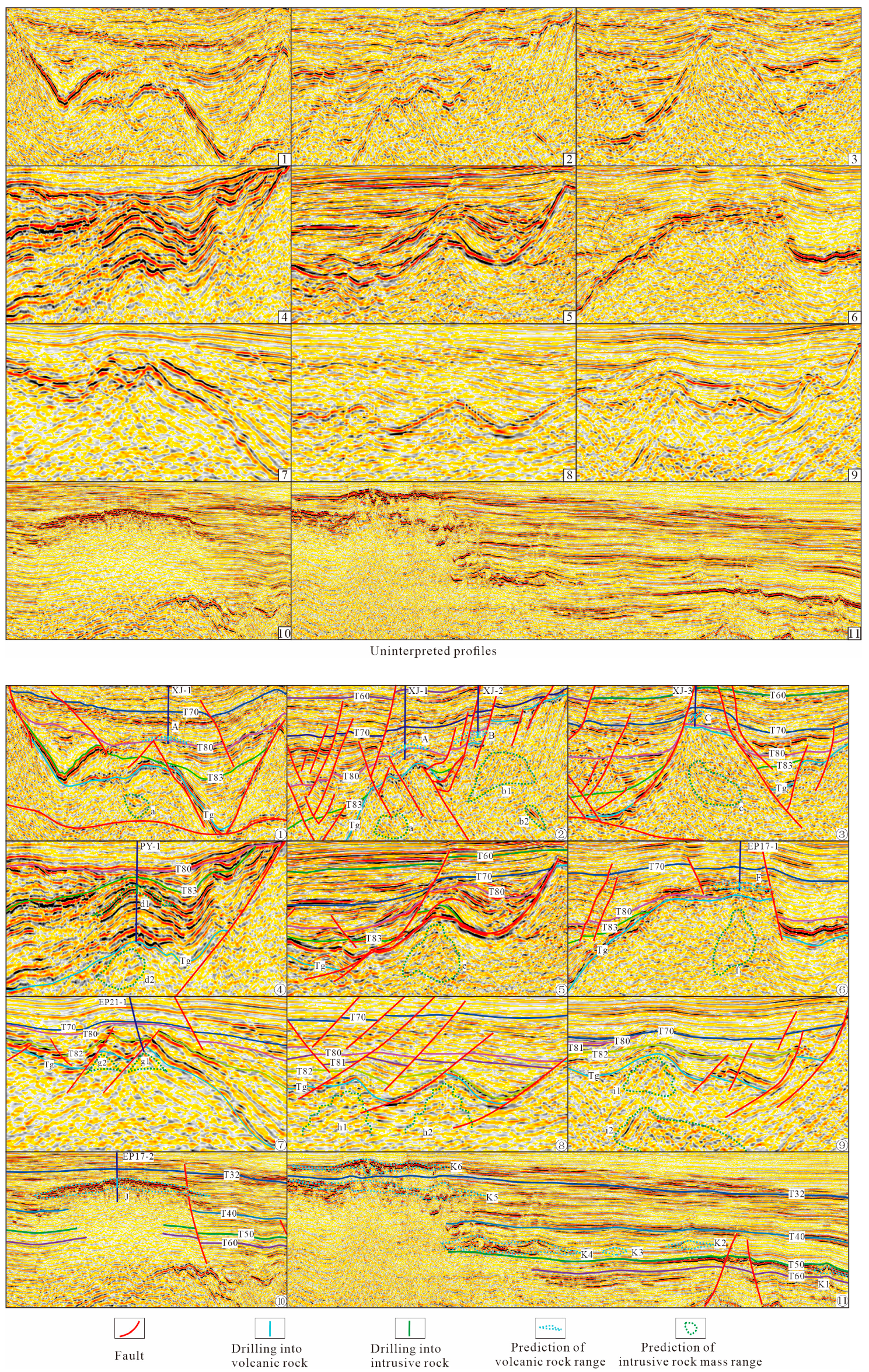
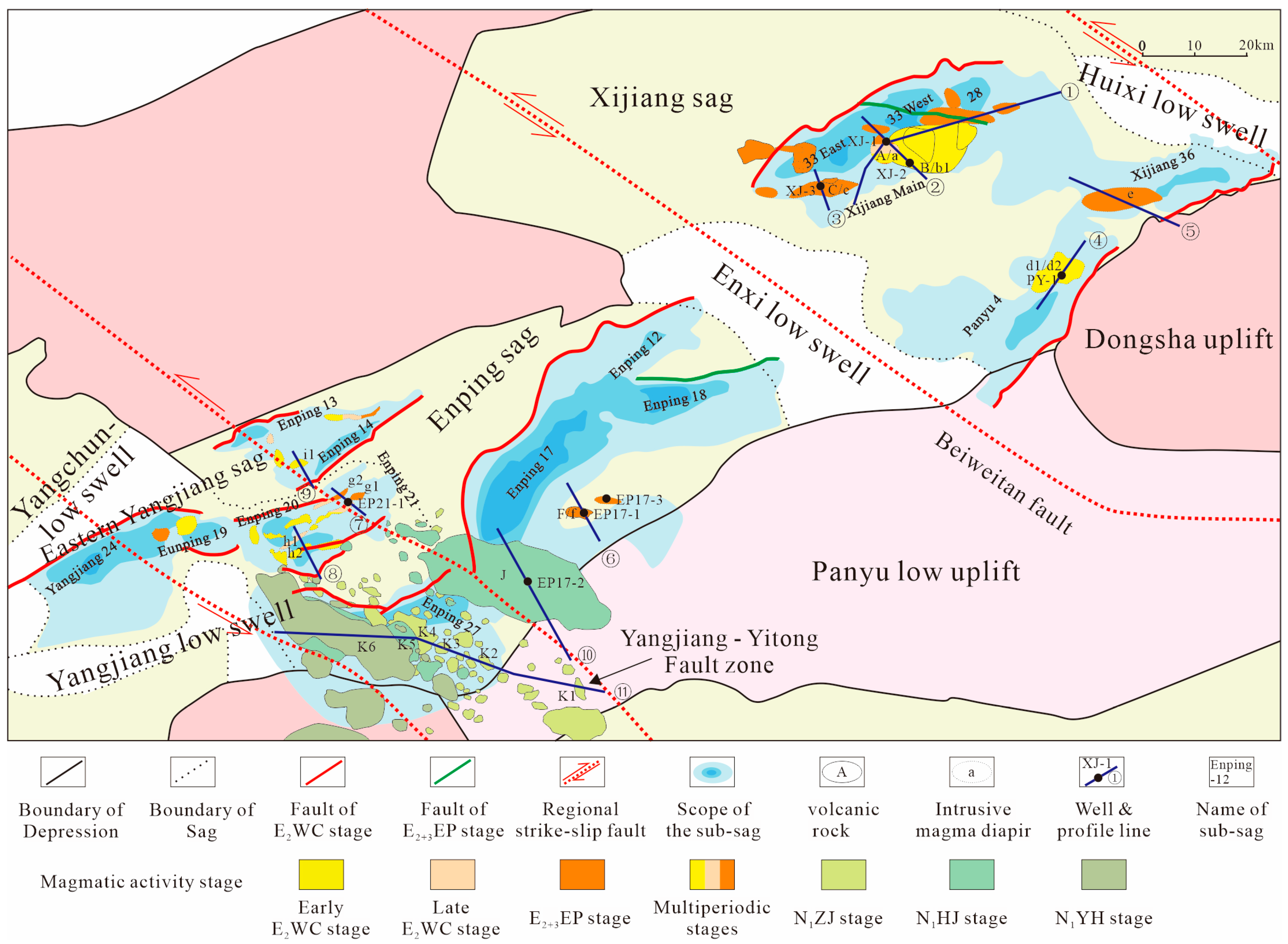
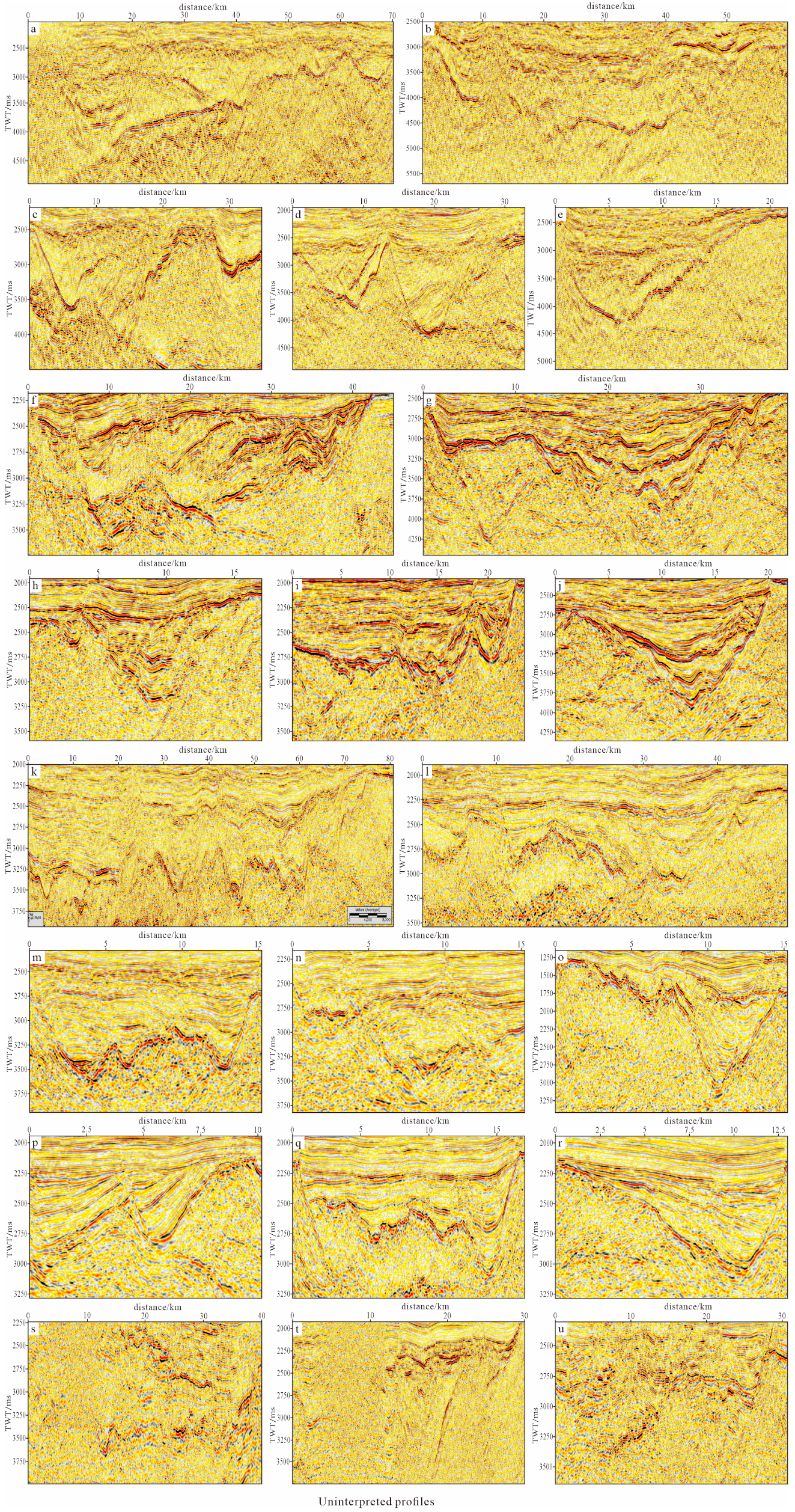
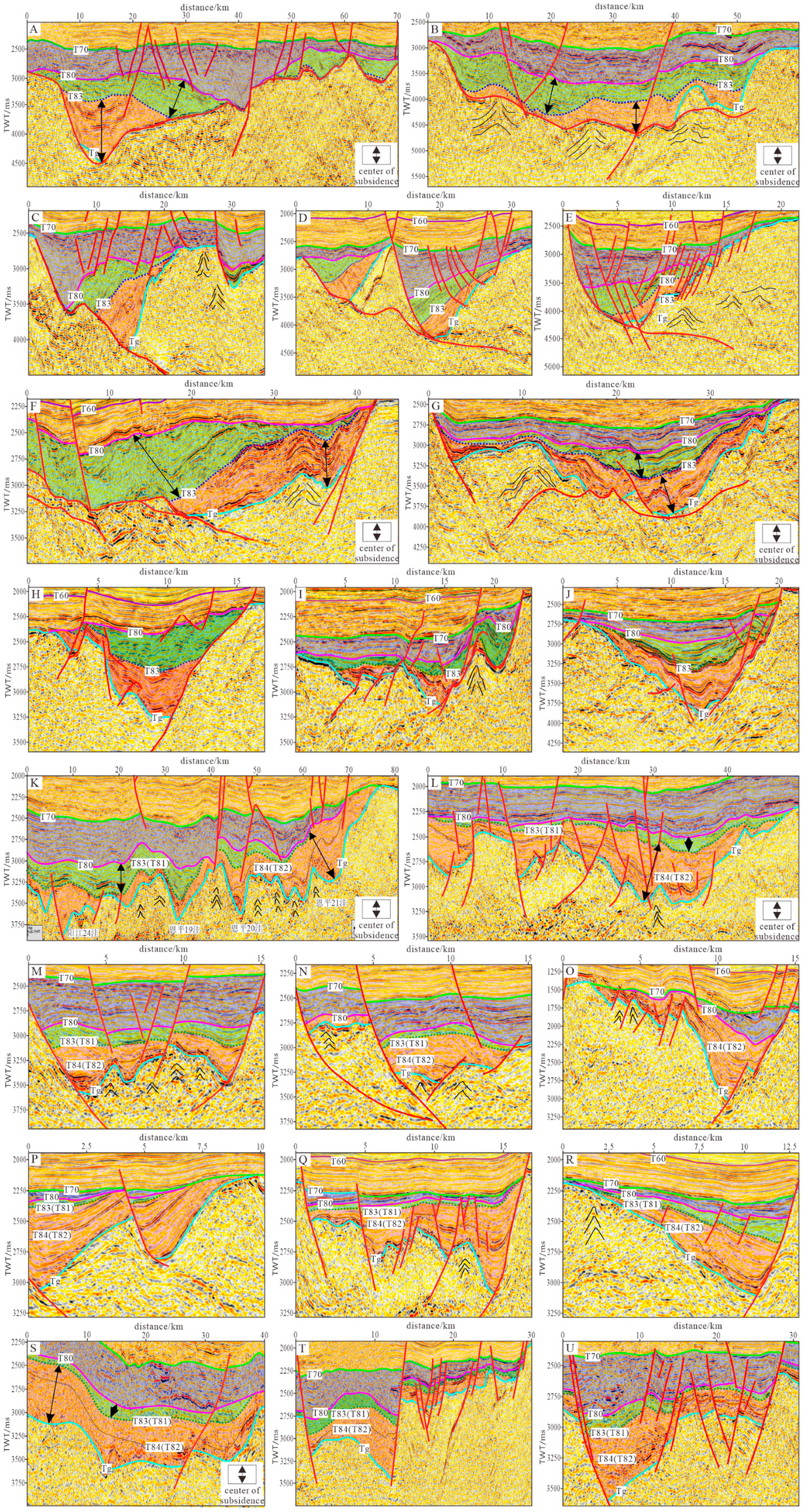
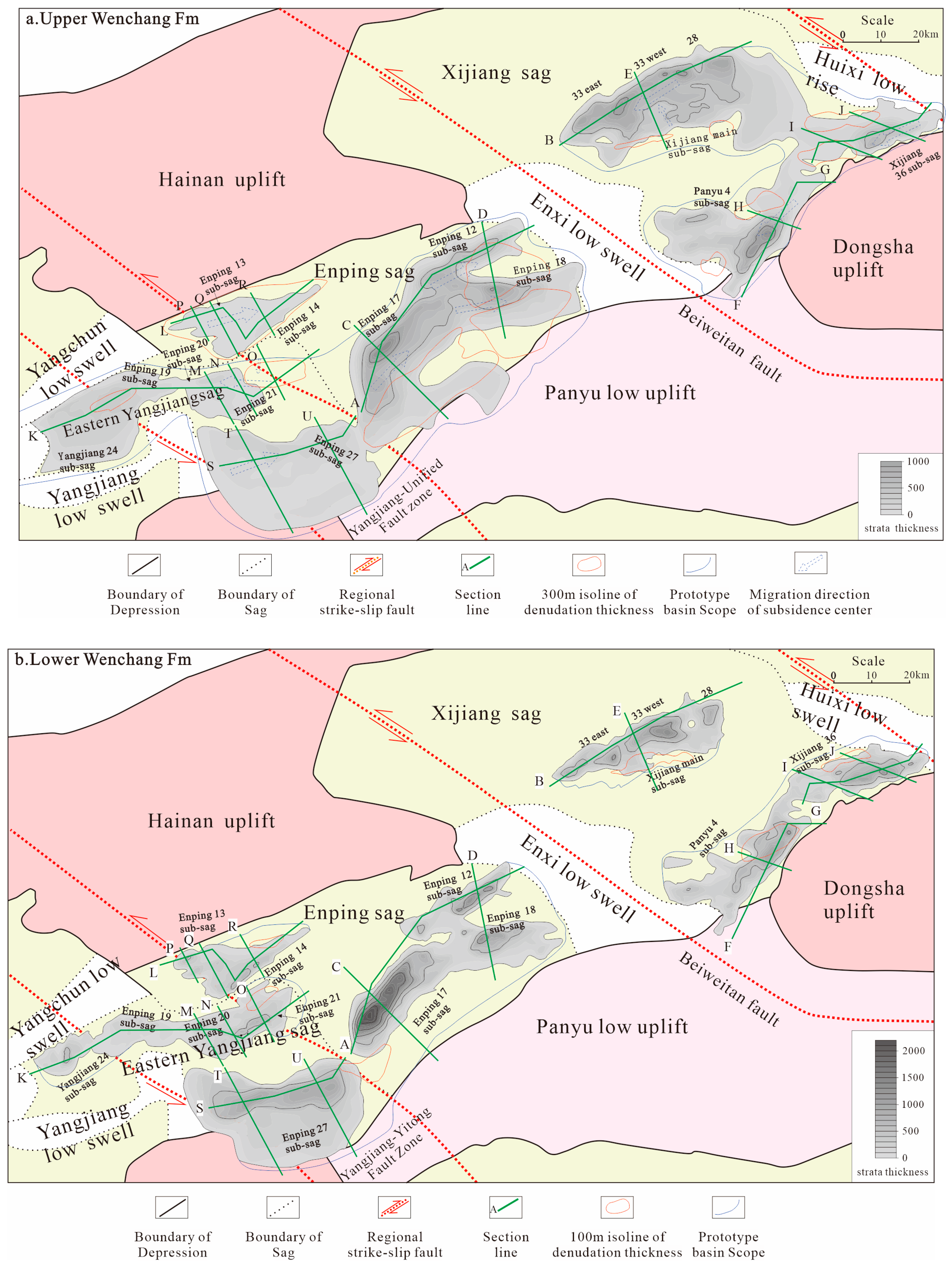

| Wellbore | Location | Lithological Characteristics | Layer | Seismic Reflection |
|---|---|---|---|---|
| XJ-1 | Xijiang main subsag | tuff | Enping Fm | Figure 3①,② |
| XJ-2 | Xijiang main subsag | basalt | Bottom of the Upper Wenchang Fm | Figure 3② |
| XJ-3 | Xijiang main subsag | basalt | Enping Fm | Figure 3③ |
| PY-1 | Panyu 4 subsag | diabase | Top of the Lower Wenchang Fm | Figure 3④ |
| EP17-1 | Enping 17 subsag | tuff, andesite | Enping Fm | Figure 3⑥ |
| EP17-2 | Enping 17/27sub-sag | basalt | Hanjiang Fm | Figure 3⑩ |
| EP17-3 | Enping 17 subsag | tuff | Enping Fm | - |
| Location | Code in Figure 2 and Figure 3 | Stage | Basis of Prediction | Seismic Reflection |
|---|---|---|---|---|
| Xijiang main subsag | A/a | Early E2WC, Late Early E2WC, E2+3EP stage | Drilling, platelike reflection, irregular large amplitude in the basement, convex reflection, fault assemblages | Figure 3①,② |
| B/b1 | Early E2WC stage | Figure 3② | ||
| C/c | E2+3EP stage | Figure 3③ | ||
| Panyu 4 subsag | d1/d2 | Early E2WC | Drilling, platelike reflection, irregular large amplitude in the basement, convex reflection | Figure 3④ |
| Xijiang 36 subsag | e | E2+3EP stage | Irregular large amplitude in the basement, convex reflection, fault assemblages | Figure 3⑤ |
| Enping 17 subsag | F/f | E2+3EP stage | Drilling, platelike reflection, irregular large amplitude in the basement, convex reflection | Figure 3⑥ |
| Enping 20/21 subsag | g1 | Early E2WC, late early E2WC, and E2+3EP stages | Drilling, irregular large amplitude in the basement, convex reflection, reference [39] | Figure 3⑦ |
| g2 | Early E2WC, late early E2WC, and E2+3EP stages | Irregular large amplitude in the basement, convex reflection, reference [39] | ||
| h1 | Late early stage | Irregular large amplitude in the basement, convex reflection | Figure 3⑧ | |
| h2 | Early E2WC stage | |||
| Enping 14 subsag | i1 | Early E2WC stage | Irregular large amplitude in the basement, convex reflection | Figure 3⑨ |
| Enping 17/27 subsag | J | N1HJ stage | Drilling, platelike reflection, convex reflection | Figure 3⑩ |
| Enping 27 subsag | K1, K2, K3, K4 | N1ZJ stage | Platelike reflection, convex reflection | Figure 3⑪ |
| K5 | N1HJ stage | |||
| K6 | N1YH stage |
Disclaimer/Publisher’s Note: The statements, opinions and data contained in all publications are solely those of the individual author(s) and contributor(s) and not of MDPI and/or the editor(s). MDPI and/or the editor(s) disclaim responsibility for any injury to people or property resulting from any ideas, methods, instructions or products referred to in the content. |
© 2023 by the authors. Licensee MDPI, Basel, Switzerland. This article is an open access article distributed under the terms and conditions of the Creative Commons Attribution (CC BY) license (https://creativecommons.org/licenses/by/4.0/).
Share and Cite
Peng, G.; Liu, P.; Chen, W.; Li, Z.; Wang, X.; Zhang, Z.; Shan, X.; Hao, G. Tectonic Transformation, Magmatic Activity and Subsidence Centre Migration of Eocene Half-Grabens: A Case Study of the Northern Pearl River Mouth Basin (PRMB) in the Northern South China Sea. J. Mar. Sci. Eng. 2023, 11, 579. https://doi.org/10.3390/jmse11030579
Peng G, Liu P, Chen W, Li Z, Wang X, Zhang Z, Shan X, Hao G. Tectonic Transformation, Magmatic Activity and Subsidence Centre Migration of Eocene Half-Grabens: A Case Study of the Northern Pearl River Mouth Basin (PRMB) in the Northern South China Sea. Journal of Marine Science and Engineering. 2023; 11(3):579. https://doi.org/10.3390/jmse11030579
Chicago/Turabian StylePeng, Guangrong, Pei Liu, Weitao Chen, Zhensheng Li, Xiaomeng Wang, Zhiwei Zhang, Xuanlong Shan, and Guoli Hao. 2023. "Tectonic Transformation, Magmatic Activity and Subsidence Centre Migration of Eocene Half-Grabens: A Case Study of the Northern Pearl River Mouth Basin (PRMB) in the Northern South China Sea" Journal of Marine Science and Engineering 11, no. 3: 579. https://doi.org/10.3390/jmse11030579
APA StylePeng, G., Liu, P., Chen, W., Li, Z., Wang, X., Zhang, Z., Shan, X., & Hao, G. (2023). Tectonic Transformation, Magmatic Activity and Subsidence Centre Migration of Eocene Half-Grabens: A Case Study of the Northern Pearl River Mouth Basin (PRMB) in the Northern South China Sea. Journal of Marine Science and Engineering, 11(3), 579. https://doi.org/10.3390/jmse11030579






